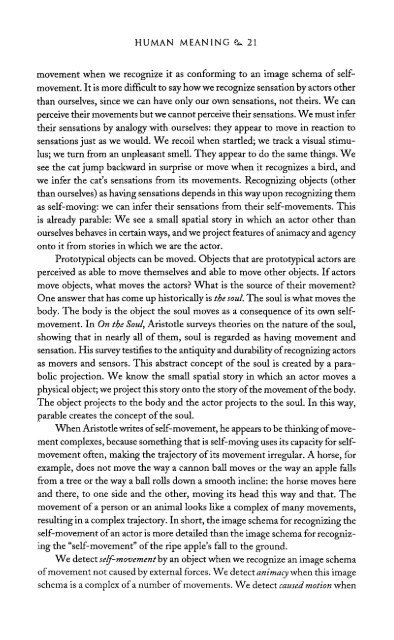The Literary Mind.pdf
The Literary Mind.pdf
The Literary Mind.pdf
You also want an ePaper? Increase the reach of your titles
YUMPU automatically turns print PDFs into web optimized ePapers that Google loves.
HUMAN MEANING 21<br />
movement when we recognize it as conforming to an image schema of selfmovement.<br />
It is more difficult to say how we recognize sensation by actors other<br />
than ourselves, since we can have only our own sensations, not theirs. We can<br />
perceive their movements but we cannot perceive their sensations. We must infer<br />
their sensations by analogy with ourselves: they appear to move in reaction to<br />
sensations just as we would. We recoil when startled; we track a visual stimulus;<br />
we turn from an unpleasant smell. <strong>The</strong>y appear to do the same things. We<br />
see the cat jump backward in surprise or move when it recognizes a bird, and<br />
we infer the cat's sensations from its movements. Recognizing objects (other<br />
than ourselves) as having sensations depends in this way upon recognizing them<br />
as self-moving: we can infer their sensations from their self-movements. This<br />
is already parable: We see a small spatial story in which an actor other than<br />
ourselves behaves in certain ways, and we project features of animacy and agency<br />
onto it from stories in which we are the actor.<br />
Prototypical objects can be moved. Objects that are prototypical actors are<br />
perceived as able to move themselves and able to move other objects. If actors<br />
move objects, what moves the actors? What is the source of their movement?<br />
One answer that has come up historically is the soul. <strong>The</strong> soul is what moves the<br />
body. <strong>The</strong> body is the object the soul moves as a consequence of its own selfmovement.<br />
In On the Soul, Aristotle surveys theories on the nature of the soul,<br />
showing that in nearly all of them, soul is regarded as having movement and<br />
sensation. His survey testifies to the antiquity and durability of recognizing actors<br />
as movers and sensors. This abstract concept of the soul is created by a parabolic<br />
projection. We know the small spatial story in which an actor moves a<br />
physical object; we project this story onto the story of the movement of the body.<br />
<strong>The</strong> object projects to the body and the actor projects to the soul. In this way,<br />
parable creates the concept of the soul.<br />
When Aristotle writes of self-movement, he appears to be thinking of movement<br />
complexes, because something that is self-moving uses its capacity for selfmovement<br />
often, making the trajectory of its movement irregular. A horse, for<br />
example, does not move the way a cannon ball moves or the way an apple falls<br />
from a tree or the way a ball rolls down a smooth incline: the horse moves here<br />
and there, to one side and the other, moving its head this way and that. <strong>The</strong><br />
movement of a person or an animal looks like a complex of many movements,<br />
resulting in a complex trajectory. In short, the image schema for recognizing the<br />
self-movement of an actor is more detailed than the image schema for recognizing<br />
the "self-movement" of the ripe apple's fall to the ground.<br />
We detect self-movement by an object when we recognize an image schema<br />
of movement not caused by external forces. We detect animacy when this image<br />
schema is a complex of a number of movements. We detect caused motion when















